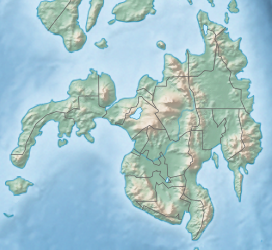Mount Balatukan
| Mount Balatukan | |
|---|---|
| |
 The mountain as seen from the western side | |
| Highest point | |
| Elevation | 2,560 m (8,400 ft)[1][2] |
| Prominence | 1,883 m (6,178 ft) |
| Listing | |
| Coordinates | 8°46′12″N 124°58′48″E / 8.77000°N 124.98000°E[1] |
| Geography | |
 | |
| Country | Philippines |
| Region | Northern Mindanao |
| Province | Misamis Oriental |
| City/municipality | |
| Geology | |
| Rock age | Holocene |
| Mountain type | Compound stratovolcano[1] |
| Volcanic arc | Central Mindanao Arc |
| Last eruption | Pleistocene age |
Mount Balatukan is a massive potentially active compound stratovolcano in the Southern island of Mindanao, Philippines. It is the highest point in the province of Misamis Oriental. The volcano has no historical eruptions but displays fumarolic activity. The 2,560-metre (8,400 ft) mountain is topped by a triangular shaped caldera 15 kilometers (9.3 mi) long and 10.6 kilometers (6.6 mi) at its widest. The Balatocan River emanates from and drains the huge crater.[3]
The mountain is a protected area in the country classified as a Natural Park, the Mount Balatukan Range Natural Park. The park has an area of 8,423.00 hectares (20,813.7 acres) with a buffer zone of 1,222.00 hectares (3,019.6 acres). It was created on March 6, 2007 by Proclamation no. 1249.[4][5]
Location
[edit]Mount Balatukan is wholly located in Province of Misamis Oriental in the Northern Mindanao region of the Philippines. The coastal road between Balingasag, Misamis Oriental and Gingoog rims the northern perimeter of the mountain on the north coast of Mindanao.
Physical features
[edit]Mount Balatukan is a stratovolcano with a listed elevation of 2,450 meters (8,040 ft) asl (GVP). The Philippine Institute of Volcanology and Seismology (PHIVOLCS).
Satellite imagery shows it to be densely forested peninsula jutting north into the Bohol Sea.[6]
Volcanism
[edit]There are no historical eruptions on Mount Balatukan. The age of its last eruption has not been studied, although some lava flows on the sides of the mountain are determined as Pleistocene. Fumarolic activity is present on the mountain, but its form displays extensive erosion.[1]
Balatukan is part of the Central Mindanao Arc of volcanoes. Its northernmost tip called Sipaka Point, which points to the northeast, is a 267 meters (876 ft) cinder cone on a small peninsula called Mount Sipaka.[7][8]
Listings
[edit]The Global Volcanism Program lists the last activity of Balatukan as Holocene but Uncertain.[9]
The Philippine Institute of Volcanology and Seismology (Phivolcs) lists Balatukan as Inactive, even though the volcano displays fumarolic activity.[10]
Mythology
[edit]In Bukidnon mythology, it is believed that upon death, all seven makatu (souls of a single person) combine into one and journeys into Mount Balatucan for final judgment. The soul first travels to the huge rock, Liyang, which is followed by a journey to Binagbasan, where the Tree of Records grows. After making a mark on the tree, the soul journeys to Pinagsayawan, where the soul must dance and sweat for atonement. The next journey is to Panamparan, where the soul gets a haircut to be presentable at Kumbirahan, where a banquet awaits the soul. The god Andalapit then leads the soul to the foot of Mount Balatucan, where the gods of the dead assemble to judge the soul. Good souls are sent to Dunkituhan, the cloud capped stairway that leads into heaven at the summit of Balatucan. An evil soul is sent to a river of penance for atonement until forgiven. Souls at the river sweat blood, the source of the river’s color and fishy scent. A forgiven soul afterwards also goes into Balatucan’s summit.[11]
See also
[edit]- List of active volcanoes in the Philippines
- List of inactive volcanoes in the Philippines
- List of potentially active volcanoes in the Philippines
- List of protected areas of the Philippines
- Pacific ring of fire
References
[edit]- ^ a b c d "Balatukan". Global Volcanism Program. Smithsonian Institution.
- ^ "The highest mountains in the Philippines". Pinoy Mountaineer. 2008-02-02. Retrieved 2008-10-29.
- ^ "Balatukan, Gingoog, Northern Mindanao, Philippines". Google Maps. Retrieved on 2013-11-15.
- ^ "Protected Areas in Region 10". Protected Areas and Wildlife Bureau. Retrieved 2013-11-22.
- ^ "Proclamation no. 1249"". Protected Areas and Wildlife Bureau. Archived from the original on 2013-12-02. Retrieved 2013-11-22.
- ^ "Satellite imagery of Balatukan Volcano". Google Maps. Retrieved on 2013-11-21.
- ^
U.S. Army Corps of Engineer (1954). "Argao (Topographic Map)". University of Texas in Austin Library. Retrieved 2013-11-24.
{{cite web}}: CS1 maint: numeric names: authors list (link) - ^ "Sipaka view from VIlla Arcadia". anoramio.com. Retrieved 2013-11-24.
- ^ "Volcanoes by name". Global Volcanism Program. Retrieved on 2013-11-15.
- ^ "Inactive Volcanoes Part 1" Archived 2015-09-24 at the Wayback Machine. Philippines Institute of Volcanology and Seismology (PHIVOLCS). Retrieved on 2013-11-15.
- ^ Myths of the Philippines; Gaverza, J.K., 2014, University of the Philippines Diliman


